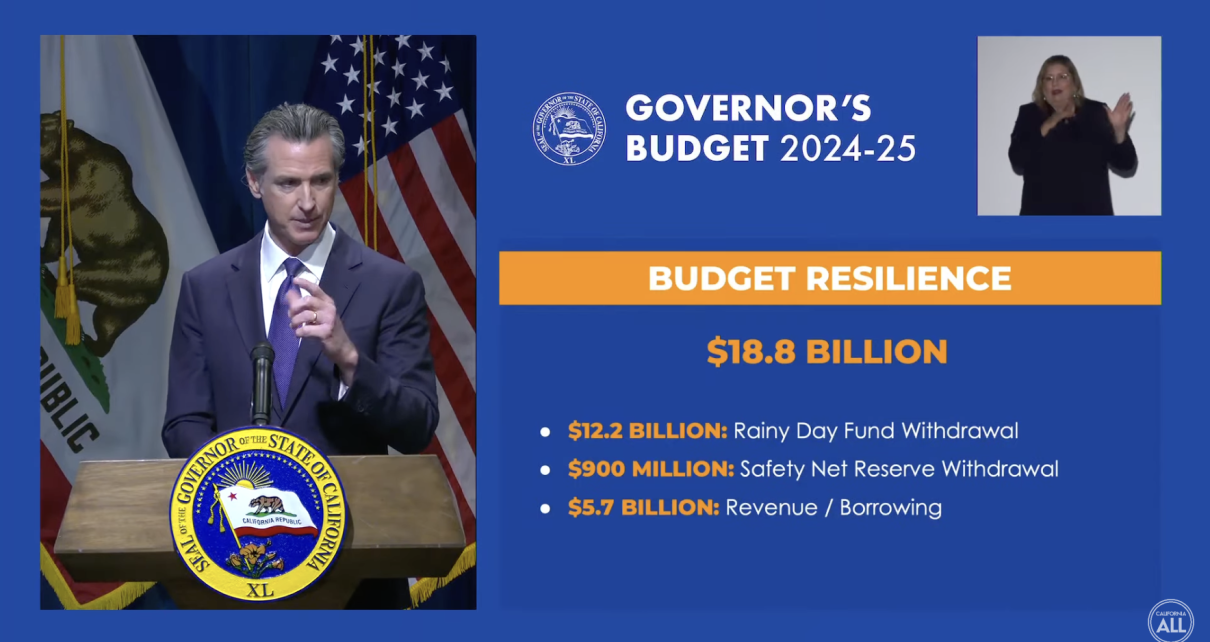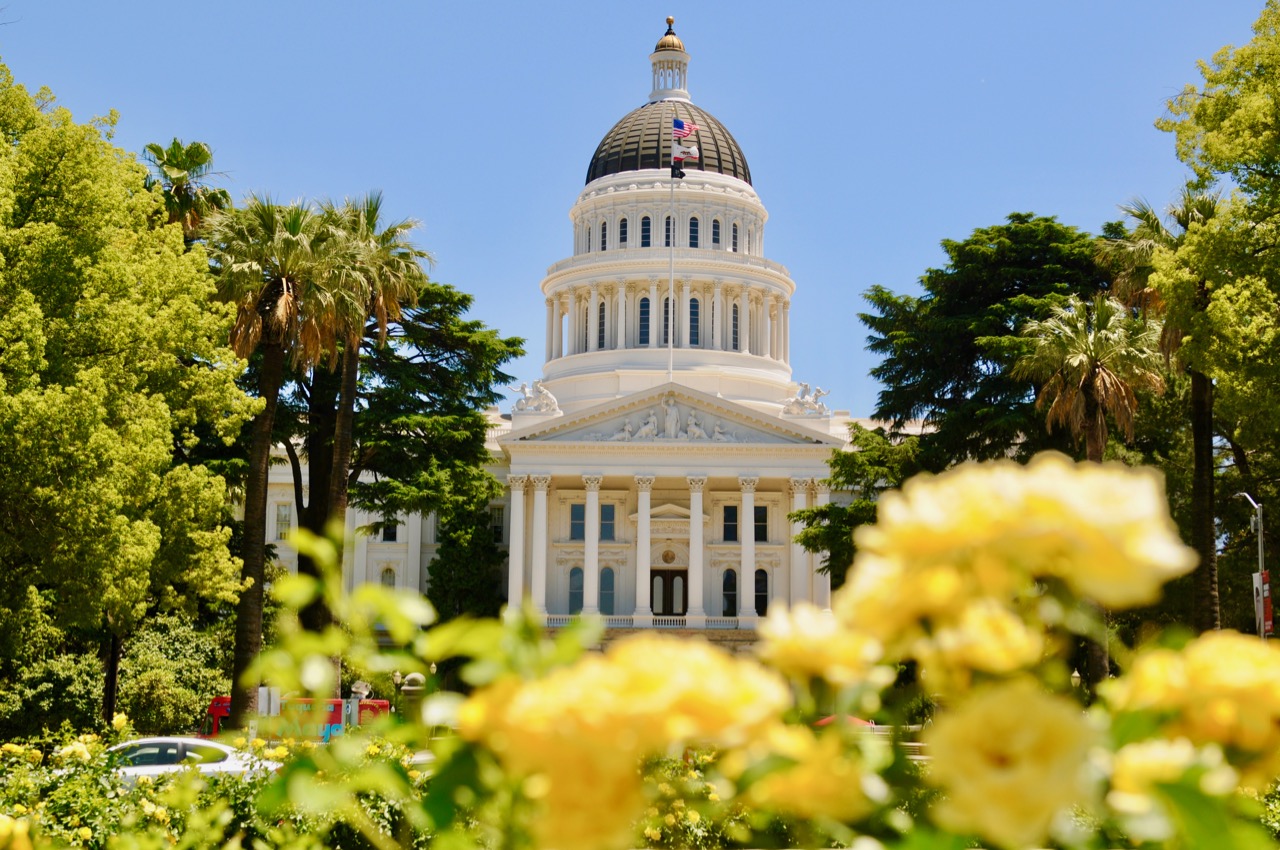
CA Gov. Gavin Newsom presenting 2024-25 budget. (Photo: gov.ca.gov)
Legislative Analyst and Gov. Newsom Still Disagree on Budget Deficit and Solutions
‘California is a model of exactly what not to do when it comes to managing a state’s finances, tax system and spending’
By Katy Grimes, May 20, 2024 7:51 am
The Legislative Analyst’s Office updated spending plan in Gov. Newsom’s revised budget shows a $55 billion budget deficit as opposed to the $27.6 billion figure Newsom presented last week, according to the Legislative Analyst’s Office. The LAO released its latest analysis of Newsom’s budget revisal Friday.
Remember the $31 billion surplus projected for 2023, which turned into a massive $25 billion shortfall in the 2023-2024 state budget? The tide completely turned in one year. The governor and Legislature overtaxed Californians and grew government while ignoring investments in critical infrastructure like new water storage, and spent an historical budget surplus of $97 billion.
LAO’s Gabe Petek said Friday the figures are different mainly because of the way the two offices account for education spending. But there are disagreements about the cut proposals. The Newsom administration has not counted the cuts to public education spending as part of the deficit.
According to the LAO’s “2024-25 Budget – Temporary Corporation Tax Increases:”
The May Revision proposes to temporarily increase corporation tax revenues by limiting the use of business tax credits and net operating loss deductions. We think the proposal to limit use of tax credits is worth serious consideration. On the other hand, the proposal to limit net operating loss deductions raises concerns. In response, we suggest the Legislature consider alternative ways to raise revenue should it wish to pursue revenue solutions.
The Governor’s administration is proposing limiting business tax credits. What they don’t seem to understand is that allowing the use of business tax credits usually brings in more money to the state, not less.
The LAO correctly notes:
Tax credits allow businesses to reduce their tax bill when they do certain activities—such as hiring certain workers and conducting research—that state policies aim to encourage. Business tax credits essentially are spending programs carried out through the state’s tax system [emphasis the Globe]. Examples include the research and development credit, the California Competes credit, and the film and television credit. The research and development credit is the state’s single largest business credit, reducing revenue by around $2 billion each year.
The May Revisions proposes to not allow businesses to use tax credits to reduce their taxes by more than $5 million for tax years 2025, 2026, and 2027.
The LAO says “While promoting private research or maintaining Hollywood’s centrality in the film industry may be worthwhile goals in general, it is not clear they are core state responsibilities which should be prioritized in the current budget environment. Further, some credits, such as the research and development credit, are awarded with limited legislative oversight. If, analogously, a proposal was before the Legislature to spend over $1 billion on research grants with fairly limited information about the recipients or the specific activities to be funded, it would be difficult to justify adopting it at the moment.”
The Legislative Analyst says the Newsom administration estimates suspending business credits and net operating loss deductions would increase corporation tax revenues:
- $900 million in 2024-25,
- $5.5 billion in 2025-26 $5.9 billion in 2026-27 and
- $3.6 billion in 2027-28.
They also say “it seems difficult to justify maintaining business credits in full at a time when meaningful spending reductions are being considered in other areas of the budget.”
As for the net operating loss deductions, the LAO doesn’t favor this option. When a business is having a tough year – when its deductible business expenses exceed its revenues in a given tax year – this is a net operating loss. The company isn’t bringing in income to cover the expenses of the business.
The LAO warns against this saying:
While the suspension of net operating loss deductions has been a go to budget solution for decades, the frequency with which this approach has been used is now starting to raise questions. Should the Governor’s proposal take effect, the state will have disallowed NOL deductions in nearly half of years between 2008 and 2027. At this rate, it seems reasonable to ask whether suspensions have begun to meaningfully undermine the purpose of allowing NOL deductions in the first place. Unlike tax credits, which are ancillary to the state’s tax system, NOL deductions are a more fundamental element aimed at ensuring taxes are levied fairly and equitably. It is not clear that the equitable treatment of taxpayers should vary with the ups and downs of the economic cycle.
The LAO offers Alternatives including a corporate tax increase, and scaling back of other tax expenditures, including those under the personal income tax:
Given our concerns with suspending NOL deductions, we suggest the Legislature consider alternative ways to raise revenues should it wish to pursue revenue solutions. As we discussed in an earlier publication, one place to look for alternatives is the scaling back of other tax expenditures, including those under the personal income tax. Another option is a temporary corporation tax rate increase. Pairing a suspension of business credits with a temporary rate increase of 1.5 percentage points (from 8.84 to 10.34) would raise a roughly similar amount of revenue as the Governor’s proposal. Such an approach could even be combined with future temporary rate reductions, which would allow business to recoup some of their temporary tax payments in future years. This would mirror one of the beneficial aspects of NOL suspensions, which is that businesses often can defer the disallowed NOL deductions to future years and reduce their future taxes.
Why not cut Medi-Cal coverage of illegal immigrants, the CalWORKs program which provides cash grants and job services to low-income families, and the administrative bloat in the state’s public education system? California Democrats and Gov. Newsom spent like drunken pirates when they had a surplus, expanding the size of state government with unnecessary spending programs.
As for state education spending, the AP reports:
The issue is the voter-approved formula for how California pays for public schools, known as Proposition 98. The formula says schools will get a certain amount of money each year. California gave public schools $76 billion in the 2022-23 fiscal year because that’s what they thought the formula required. However, state tax collections that year ended up being 25% less than what the state had predicted.
The Newsom administration says that retroactively impacted the formula for public school funding. Now, they say the state was only required to give schools roughly $67 billion that year. It’s an $8.8 billion difference. [emphasis the Globe]
In April the Globe reported on the first disagreement between the governor and the LAO:
California has a budget deficit of $73 billion, the Legislative Analyst’s Office reports. Gov. Newsom claimed the budget deficit was only $30 billion in January. So who is right – the nonpartisan LAO or Gov. Newsom who isn’t running for president?
As the Globe recently reported, Gov. Gavin Newsom’s final expansion of full-scope Medi-Cal went into effect Monday, January 1, 2024, making more than 700,000 illegal immigrants residents between ages 26 and 49 eligible for full health care coverage – at a very precarious time with his $68 billion budget deficit.
As the Globe reports on every budget discussion, It is important to remember that when Gov. Jerry Brown was (re)elected in 2011, the state budget was $98 billion. The state’s population was a little over 38 million. Brown doubled the budget to $199.3 billion in 8 years – with no measurable increase in population. Gov. Gavin Newsom inherited Brown’s $199.3 billion budget, and has grown it to $330 billion in 5 years – while losing population.
If Gavin Newsom and the state’s Democrats – who surely flunked basic math – are trying to bankrupt the state, they are going about it correctly. This expansion of Medi-Cal will cost $2.6 billion annually on top of the $330 billion budget.
And notably, California is the only state in the country to fund health care for illegal immigrants. As California Congressman Kevin Kiley says, “California is a model of exactly what not to do when it comes to managing a state’s finances and managing its tax system and spending.”
- AG Bonta Promotes California’s ‘Migrant Community’ Over California Citizens - December 20, 2025
- HHS Acts to Bar Hospitals from Performing Sex-Rejecting Procedures on Children - December 19, 2025
- Top 50 Disasters Gov. Gavin Newsom Has Ushered into California: 2025 Edition - December 17, 2025





The tax credit program is also used for incentivizing low income (over the top expensive) housing. If they reduce those incentives in that area, they are directly impacting pet projects and donors to the Democratic/establishment cause. It will be interesting to see if they really are cutting tax credits to this program. As far as the budget the solution is both difficult and simple. It is impossible/difficult for Newsom to produce a realistic budget that will create a stable economic environment for California because (you can fill in the blank reason). For a leader that actually wants to see California thrive this budget mess creates a unique/simple situation to reign in runaway government spending and reduce the overall size and scope of the State government. By solving this budget mess, you would actually be able to cut taxes and return money to the pockets of hard-working Californians.
Speaking of:
“EXCLUSIVE – More than 1200 L.A. city-owned homeless housing units remain vacant two years after”
https://www.westsidecurrent.com/news/exclusive-more-than-1-200-city-owned-homeless-housing-units-remain-vacant-two-years-after/article_473f6a78-11e9-11ef-92b9-0b22ca012708.html
How much will Community College Chancellor Sonya Christian’s proposal to dramatically expand (and require) dual enrollment courses cost Californians? In 2022-23, 40% of the students at Christian’s own Bakersfield College were dual enrollment students – high school students taking classes on the taxpayer’s dime. Sounds unethical to me. Now she wants to offer as many programs as possible as “apprenticeships”: from registered nursing to pool & spa care to video game design. It’s tucked away in a state program named the “California Apprenticeship Initiative”.
How much has it cost taxpayers to offer a plethora of bachelors degrees at the community colleges? The LAO examined this in 2019 and found the costs outweighed the benefits.
How much has it it cost taxpayers to relabel Humboldt State as Cal Poly Humboldt?
How much will it cost taxpayers to eliminate California-based petroleum production? Keep in mind that the sole partner to Gavin Newsom’s business empire is the Getty Oil family, who earned their fortune in the oilfield of California.
Here is a list of the programs being funded by the California Apprenticeship Initiative: https://www.cccco.edu/-/media/CCCCO-Website/docs/memo/ESLEI-2416-California-Apprenticeship-Initiative-New-and-Innovative-Grant-Program-FY-2324-Notice-of-I.pdf?la=en&hash=D179D3FD96EA1A4D49C449BE3A65D61CCA9A7CF1&hash=D179D3FD96EA1A4D49C449BE3A65D61CCA9A7CF1
More lists are are available under the title “Notices of Intent to Award” on this webpage: https://www.cccco.edu/About-Us/Chancellors-Office/Divisions/Workforce-and-Economic-Development/apprenticeship/ca-apprenticeship-initiative
The state should reclaim the $50 million in state funding that was allocated to the so-called California Renewable Energy Laboratory. CREL which consists of an office (no lab) in the Kern Community College District Office and is managed by a former psychology professor from Bakersfield College. If nothing else, the LAO should investigate CREL as there is no research being done, only webinars and workshops. Sonya Christian was formerly the chancellor of the Kern Community College District. https://www.kccd.edu/crel/index.html
Once the ranks of the ‘on the system” voters sufficiently expanded, rescinding of prop. 13 will occur.
My favorites on their apprentice list are restaurant cook and construction laborer. Seems the world has been able to provide All these listed jobs without state help or yet another “ certificate”.
Locally we have a state university that offers a degree in sales. Sales…..
This is about these institutions trying to stick around as more and more people realize their offerings aren’t worth the steep price.
Buying social standing through a certification game is winding down, and they see the writing on the wall. How many kids do you know that don’t work in the field they graduated in already?
How is that ever going to improve?
California has among the highest taxes in the country yet has nothing to show for it. The roads and other infrastructure among the worst in the country. Homeless encampments are everywhere. Public schools are abysmal. Where’s all that tax money going? No doubt most of it’s being siphoned off by the criminal Democrat mob that controls the state and their cronies? California has become a failed state much like Venezuela or Cuba?
With Demunists in complete control, Californians will continue to suffer from these confiscatory taxes. And the milquetoast Republican never-Trumpers will enciurage it. California hasn’t had a free and fair election since Grey Davis refused to defend Proposition 187 and One-Bill Gil’s licenses for illegal aliens was passed with the motor voter bill sealing the continuous election fraud. Multiple polling locations and vote by mail schemes continues the election charades with no relief in sight. How do I know all of this? I spent four years in litigation against a vendor for the Secretary of State a quarter century ago., and I pay attention.
Thank you for reporting on this, the details of which are ignored by the media. Of all of California’s problems, this is the fundamental issue, described here, in short, machine politics that divert public funds from essential projects in order for certain people to maintain their political fiefdoms